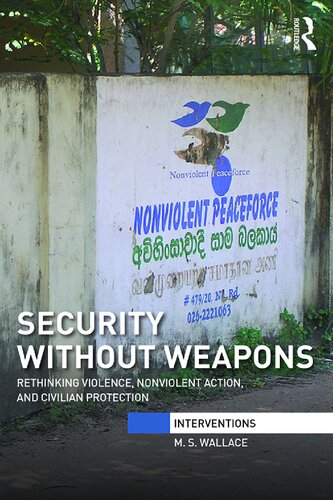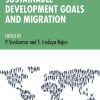Security Without Weapons Rethinking cction and civilian protection 1st Edition by Wallace ISBN 1138944866 978-1138944862
$50.00 Original price was: $50.00.$25.00Current price is: $25.00.
Security Without Weapons Rethinking cction and civilian protection 1st Edition by Wallace- Ebook PDF Instant Download/Delivery: 1138944866 978-1138944862
Full download Security Without Weapons Rethinking cction and civilian protection 1st edition after payment

Product details:
ISBN 10: 1138944866
ISBN 13: 978-1138944862
Author: Wallace
Few questions of global politics are more pressing than how to respond to widespread violence against civilians. Despite the efforts of Responsibility to Protect (R2P) proponents to draw attention away from exclusively military responses, debates on humanitarian intervention and R2P’s “Third Pillar” still tend to boil down to two unsatisfying options: stand by and “do nothing” or take military action to protect civilians – essentially using violence to stop violence. Accordingly – and given disagreement and uncertainty regarding moral claims, as well as the unpredictability of military effectiveness – this book asks: how can we counter violence ethically and effectively, taking action consistent with our particular moral commitments while also nurturing difference and enacting responsibility towards multiple others?
After evaluating the pragmatic and ethical failings of military action, the book proposes nonviolent intervention as a third – unarmed, on-the-ground – option for protecting civilians during humanitarian crises. In the empirical section of the book, focusing on the discursive and psychological conditions enabling violence, Wallace analyses the mechanisms by which Nonviolent Peaceforce – an international NGO engaged in nonviolent intervention/ unarmed civilian peacekeeping (UCP) – was able to protect civilians and prevent violence, even if on a limited scale, in the broader context of Sri Lanka’s war/counterinsurgency in 2008.
Both philosophically innovative and practically useful to those working in the field, the book contributes to a range of literatures and debates: from just war theory and poststructuralist ethics to nonviolent action and conflict transformation, and from humanitarian intervention, R2P, and civilian protection to strategic theory and discursive and psychological theories of violence.
Security Without Weapons Rethinking cction and civilian protection 1st Table of contents:
-
Introduction: Rethinking Security
- The traditional concepts of security and the limitations of military approaches
- The need for new frameworks in the protection of civilians
- Objectives of the book and the broader debate on non-violent security
-
Chapter 1: Understanding Security Without Weapons
- Defining security in a non-military context
- Historical examples of civilian protection without the use of force
- Theories of non-violent action and peacebuilding
-
Chapter 2: The Evolution of Civilian Protection
- The rise of civilian protection in conflict zones
- The role of international law and human rights frameworks
- The development of “Responsibility to Protect” (R2P) and its impact
-
Chapter 3: Non-Violent Approaches to Conflict Resolution
- Methods of non-violent action: diplomacy, negotiation, and civil resistance
- The role of grassroots movements and local communities in peacebuilding
- Case studies of successful non-violent interventions
-
Chapter 4: Humanitarian Intervention and Protection
- The intersection of humanitarian aid and civilian protection
- The challenges of protecting civilians in war zones without military intervention
- The role of the United Nations and non-governmental organizations (NGOs)
-
Chapter 5: The Role of Civilian Peacekeeping Forces
- The concept of civilian peacekeeping and unarmed protection
- Case studies of civilian peacekeeping initiatives (e.g., Nonviolent Peaceforce)
- The effectiveness and limitations of civilian peacekeepers in conflict zones
-
Chapter 6: Conflict Prevention and Early Warning Systems
- Strategies for preventing conflicts before they escalate
- The role of early warning systems in detecting potential threats to civilian safety
- The importance of diplomatic engagement in conflict prevention
-
Chapter 7: Building Resilience in Vulnerable Communities
- Empowering local populations to withstand conflict and violence
- Community-led approaches to building long-term peace and security
- Strategies for enhancing resilience in post-conflict societies
-
Chapter 8: Security in the Digital Age
- The impact of cybersecurity on civilian protection
- Addressing threats like cyber warfare, misinformation, and digital surveillance
- The role of technology in non-violent security strategies
-
Chapter 9: The Ethics of Security Without Weapons
- Ethical considerations in choosing non-violent approaches to security
- The moral responsibility of states and organizations in protecting civilians
- The challenges of balancing peacekeeping efforts with state sovereignty
-
Chapter 10: Toward a New Paradigm of Security
- Integrating non-violent protection strategies into national and international security policies
- The future of civilian protection and the changing nature of warfare
- Vision for a world where security is achieved without weapons
-
Conclusion: The Path Forward
- Summary of key findings and conclusions
- Recommendations for policymakers, humanitarian actors, and peacebuilders
- The potential for global change in how we think about and implement security
People also search for Security Without Weapons Rethinking cction and civilian protection 1st:
security without borders
nonviolent weapons
violence without regret
security weapon
c security vulnerabilities
Tags:
Wallace,Security Without,civilian protection,violence nonviolent
You may also like…
Politics & Philosophy - Politics
Uncategorized
Politics & Philosophy - Social Sciences
Uncategorized
Violence Without Borders The Internationalization of Crime and Conflict 1st Edition World World Bank
Jurisprudence & Law - Intellectual Property
Fiction - Others
Science (General) - Science of Science
Computers - Security











